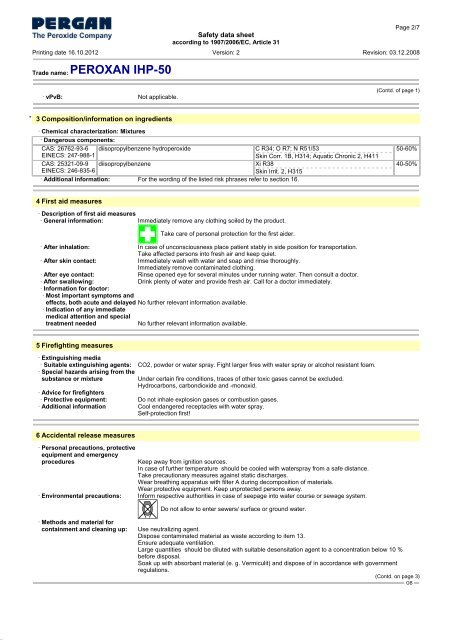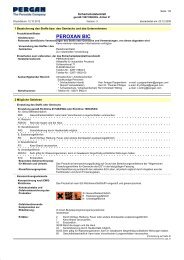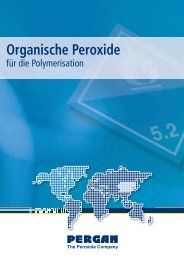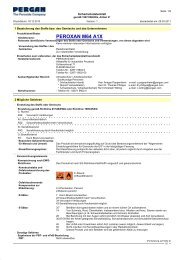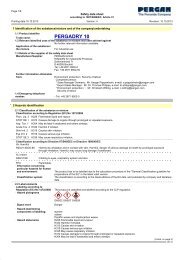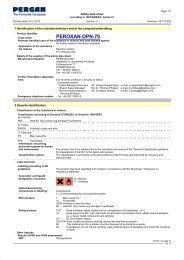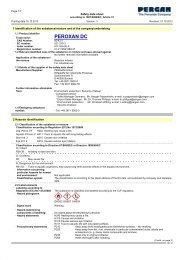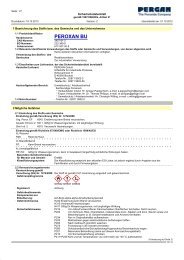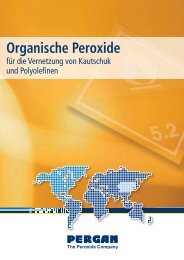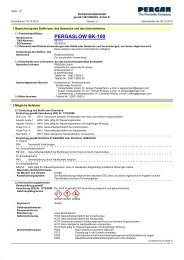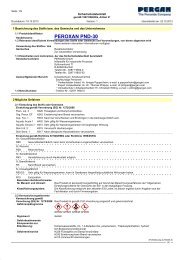PEROXAN IHP-50 - Pergan GmbH
PEROXAN IHP-50 - Pergan GmbH
PEROXAN IHP-50 - Pergan GmbH
You also want an ePaper? Increase the reach of your titles
YUMPU automatically turns print PDFs into web optimized ePapers that Google loves.
35.0.33<br />
Page 2/7<br />
Printing date 16.10.2012<br />
Safety data sheet<br />
according to 1907/2006/EC, Article 31<br />
Version: 2<br />
Revision: 03.12.2008<br />
Trade name: <strong>PEROXAN</strong> <strong>IHP</strong>-<strong>50</strong><br />
· vPvB: Not applicable.<br />
* 3 Composition/information on ingredients<br />
· Chemical characterization: Mixtures<br />
· Dangerous components:<br />
CAS: 26762-93-6 diisopropylbenzene hydroperoxide C R34; O R7; N R51/53<br />
EINECS: 247-988-1<br />
Skin Corr. 1B, H314; Aquatic Chronic 2, H411<br />
CAS: 25321-09-9 diisopropylbenzene Xi R38<br />
EINECS: 246-835-6<br />
Skin Irrit. 2, H315<br />
· Additional information: For the wording of the listed risk phrases refer to section 16.<br />
4 First aid measures<br />
· Description of first aid measures<br />
· General information: Immediately remove any clothing soiled by the product.<br />
?Z<br />
Take care of personal protection for the first aider.<br />
· After inhalation: In case of unconsciousness place patient stably in side position for transportation.<br />
Take affected persons into fresh air and keep quiet.<br />
· After skin contact: Immediately wash with water and soap and rinse thoroughly.<br />
Immediately remove contaminated clothing.<br />
· After eye contact: Rinse opened eye for several minutes under running water. Then consult a doctor.<br />
· After swallowing: Drink plenty of water and provide fresh air. Call for a doctor immediately.<br />
· Information for doctor:<br />
· Most important symptoms and<br />
effects, both acute and delayed No further relevant information available.<br />
· Indication of any immediate<br />
medical attention and special<br />
treatment needed No further relevant information available.<br />
5 Firefighting measures<br />
· Extinguishing media<br />
· Suitable extinguishing agents: CO2, powder or water spray. Fight larger fires with water spray or alcohol resistant foam.<br />
· Special hazards arising from the<br />
substance or mixture Under certain fire conditions, traces of other toxic gases cannot be excluded.<br />
Hydrocarbons, carbondioxide and -monoxid.<br />
· Advice for firefighters<br />
· Protective equipment: Do not inhale explosion gases or combustion gases.<br />
· Additional information Cool endangered receptacles with water spray.<br />
Self-protection first!<br />
6 Accidental release measures<br />
· Personal precautions, protective<br />
equipment and emergency<br />
procedures Keep away from ignition sources.<br />
In case of further temperature should be cooled with waterspray from a safe distance.<br />
Take precautionary measures against static discharges.<br />
Wear breathing apparatus with filter A during decomposition of materials.<br />
Wear protective equipment. Keep unprotected persons away.<br />
· Environmental precautions: Inform respective authorities in case of seepage into water course or sewage system.<br />
?K@JL<br />
Do not allow to enter sewers/ surface or ground water.<br />
(Contd. of page 1)<br />
<strong>50</strong>-60%<br />
40-<strong>50</strong>%<br />
· Methods and material for<br />
containment and cleaning up: Use neutralizing agent.<br />
Dispose contaminated material as waste according to item 13.<br />
Ensure adequate ventilation.<br />
Large quantities should be diluted with suitable desensitation agent to a concentration below 10 %<br />
before disposal.<br />
Soak up with absorbant material (e. g. Vermiculit) and dispose of in accordance with government<br />
regulations.<br />
(Contd. on page 3)<br />
GB


